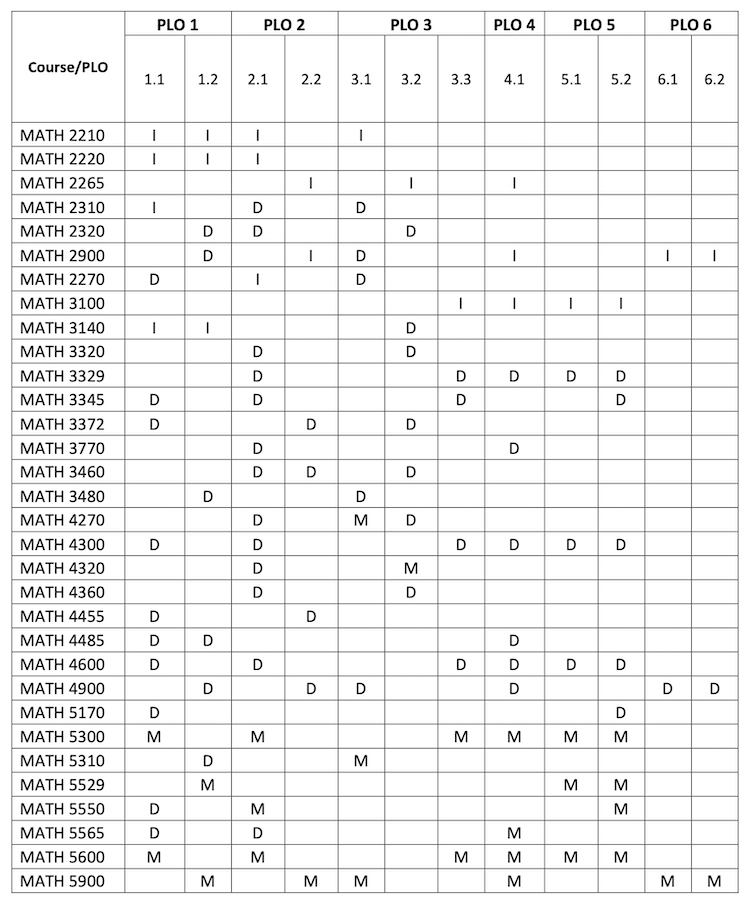Undergraduate Programs Assessment Plan
Fall 2020 – Spring 2024
Description of current information from assessment being used to design the transformed programs.
As a result of Q2S transformation activities (including professional development at the Teaching Resource Center’s Principles of Program Design Institutes in the areas of threshold concepts, disciplinary ways of thinking, and backwards program design), the department transformation teams modified the program learning outcomes: 15 of the outcomes under Goals 1-5 have been reduced down to 10 essential outcomes, which will be more manageable for future assessment.
Information from assessment data for 2016-17 and 2017-18 was used:
-
to develop a new course (Math 3100, Mathematical Thinking: Communication and Proof) as a “foundations in mathematical reasoning and communication” experience for the new semester program that would be a common prerequisite to more advanced proof-based courses. This is an upper division course to ensure equity in preparation of skills in this critical area. Additionally, this course is designated as a Writing Intensive (WI) course and requires students to critique reasoning and judge the validity of mathematical arguments and incorporate the use of technology so that students learn how to write in the discipline using appropriate software (Latex, for example). This experience will benefit students as they develop their ability to read and write mathematical proofs before continuing with more advanced proof courses such as Math 4300, Math 4600, and others.
-
to revise courses so that there is an emphasis on conceptual understanding, problem solving, and applications. A variety of course pedagogies and curriculum materials are also being considered for course redesign to allow for more student-centered activities and student engagement.
Program Learning Outcomes (PLOs)
Goal 1 Students will demonstrate a conceptual understanding of mathematics
- Students will demonstrate an understanding of fundamental concepts, algorithms, operations, and relations
- Students will make connections between mathematical ideas verbally, numerically, analytically, visually, and graphically
Goal 2 Students will attain procedural fluency in mathematics
- Students will correctly apply mathematical theorems, properties and definitions
- Students will calculate efficiently, flexibly, and with appropriate accuracy
Goal 3 Students will demonstrate adaptive reasoning and problem-solving skills in mathematics
- Students will justify solutions using a variety of strategies and representations
- Students will be able to evaluate reasonableness of proposed results using estimation and context
- Students will be able to critique mathematical reasoning, both correct and flawed
Goal 4 Students will demonstrate mathematical communication skills
-
Students will demonstrate mathematical communication skills using appropriate mathematical vocabulary and references
Goal 5 Students will understand and produce correct mathematical proofs
-
Students will understand valid mathematical proofs
-
Students will produce valid mathematical proofs
Goal 6 Students will reflect on their mathematical experiences
-
Students will be able to analyze mathematical content of the secondary classroom, including content and practice standards
-
Students will connect mathematical concepts within and between secondary and undergraduate levels
Note:
Goals 1-5 are for the BA and BS General/Applied Concentrations.
Goal 6 is for the BS Teaching Concentration only.
Curriculum alignment to PLOs for the purposes of assessment
For more details, please see:
- CSUSB Math Department Assessment Alignment Matrix spreadsheet, or the
- Program Student Learning Outcomes (PLOs) pdf table.
Legend: I = Introduced, D = Developed, M = Mastered
Measures and methods to be used to collect data and review data
Note: Since the BA and BS programs share 10 common learning outcomes, the core curriculum is assessed and reported as the “Undergraduate Programs in Mathematics” with an additional component for PLO 6.1 and 6.2 for the BS Teaching Concentration.
PLO 1.1, 1.2, 2.1, 2.2, 3.1, and 3.2
- Performance tasks in lower and upper division courses (not including 3100, 5300, 5600, and 5529)
PLO 3.1, 3.3, 4.1, 5.1, and 5.2
- Written work samples and performance task in Math 3100
- Written work samples and performance task in Math 5300, Math 5600, Math 5529
Note: Data from instructor course records will be shared with the Mathematics Department Assessment Committee (MDAC).
PLO 6.1 and 6.2
- Student activity write-ups and presentations in Math 5900
- Student written reflections in Math 5900
Note: Data from instructor course records will be shared with MDAC.
Performance tasks will be developed and scored by the Math Department Assessment Committee in consultation with faculty teaching the relevant courses. Data from all activities will be shared (via Google docs) and reviewed/discussed with department faculty.
Timeline for rotating through the assessment of the program student learning outcomes
Three to four outcomes will be assessed each academic year as follows:
|
2020-21 |
2021-2022 |
2022-2023 |
2023-2024 |
|
2.2 3.2 6.2 |
1.2 3.1 4.1 6.1 |
1.1 2.1 6.2 |
3.3 5.1 5.2 6.1 |
Closing the loop:
Program faculty will examine assessment data each year and compare to prior year data to consider any adjustments to the design of the new semester program and relevant courses. Changes to the program will not be made in the first two years of the semester program.
